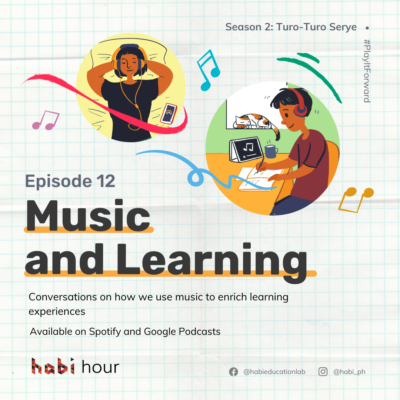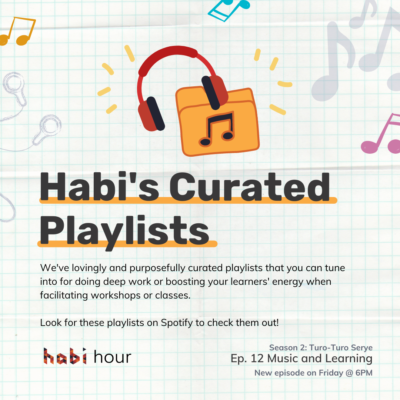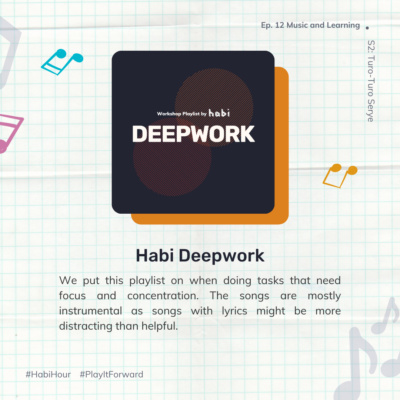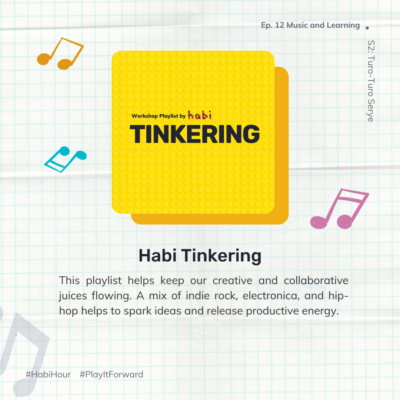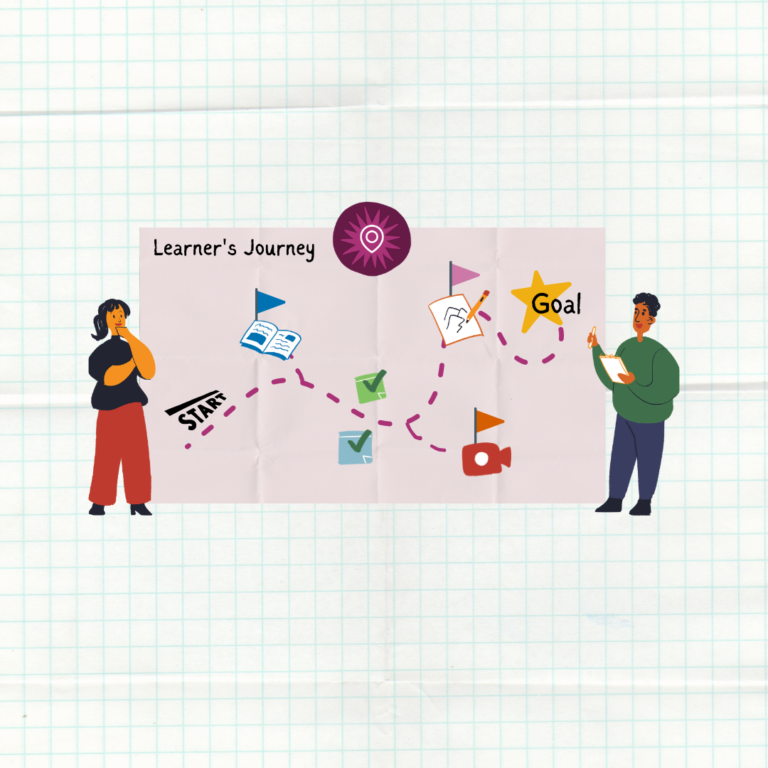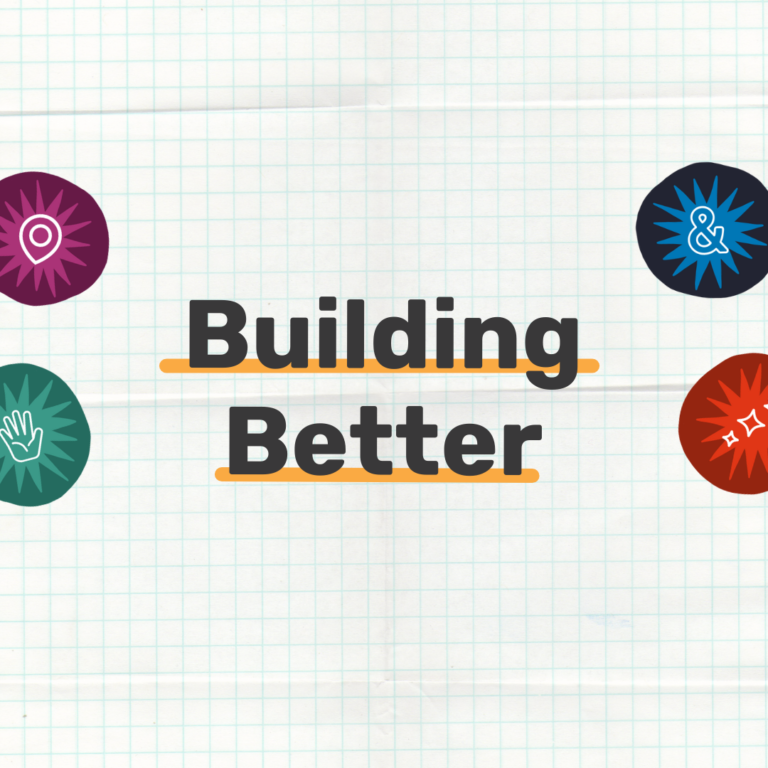Conversations on how we use music to enrich learning experiences
Overview
25 June 2021 | 12 min and 53s
Does music support student learning? How do we use music to enrich a learning experience? In this episode of Habi Hour, let’s listen to our learning experience designers, Chess and Amiel, and Manghahabi Teachers Bettina, Kat and Mike, as they share how they use music in their diverse teaching and learning contexts.
Let’s see how we can carefully craft and design the elements of our learning environment – from the space, the people, to the processes, and how music can be part of the space too!
Curious to know more about the connection between music and learning? Here’s a https://bit.ly/resourceshabihourS2E12 to the references used in this episode as well as a collection of our curated playlists for Habi workshops and activities!
Transcript
Introductions and Check In
CHESS: Nakikinig ka ba sa music habang nag-aaral or nagtratrabahaho? Anong klaseng music ang pinakikinggan mo? Sa mga Habi workshops, baka napapansin ninyo na mahilig kaming magpatugtog ng music – minsan sa simula, habang dumadating ang participants, minsan habang gumagawa ng tasks, minsan habang break.
In this episode of Habi Hour, let’s continue our conversation on creative teaching and learning by exploring these questions – does music support student learning? How do we use music to enrich a learning experience?
Ako si Chess at makakasama natin si Amiel, isa ring learning experience designer sa Habi at kapwa music enthusiast. Kami ang inyong mga kakuwentuhan for this episode on “Music and Learning.”
[MUSIC: Habi Hour Intro]
Kuwentuhan
AMIEL: Alam mo actually, Chess, nung bata ako mahilig na ako sa music dahil mahilig ako sumayaw before. And then, actually, music din yung nagdala sa akin sa community service.
Doon nagsimula yung interest kong sumali sa choir. Doon nahubog yung relationship ko sa music hindi lang as a choir member but as an individual. Malaki kasi yung contribution niya especially sating mga Pilipino diba. Super mahal natin yung…ayan mahilig tayo magkaraoke, kumanta. Nasa dugo nating mga Pilipino iyan. Kaya maraming talented sa ‘tin na kumanta’t sumayaw
CHESS: Something similar with you, kasi parang lagi siyang bahagi ng buhay ko. Para kong actually may soundtrack palagi, kapag may ginagawa. Nakikinig ako ng music habang nag-cocommute. Meron akong commute music, ganyan. Meron akong music kapag naglilinis ako. Parang kasami ko nga lagi yung music. Para akong may background music
Napaisip ako kung paano ako unang naintroduce sa kaniya, siguro din with family. Plus 1 doon sa sobrang lapit niya sa culture natin as Filipinos.
CHESS: What makes music so intrinsically linked to our lives? Ayon sa mga pananaliksik at pag-aaral, “Music is a universal language; it appears in every society observed, and has accompanied major social events throughout the history of mankind” (Kwong, 2016).
“Major gatherings such as weddings, graduations, or birthdays are usually recognized by a familiar tune” (Kwong, 2016). Kung papansinin natin, ang mga celebration at kaganapan sa Filipino society ay kadalasan may musika at kantahan. Now we’d like to see how the space of teaching and learning can also be accompanied and enriched by music.
AMIEL: For me yung role ng music sa mga learning activities, kung paano siya nakakapagcreate ng creative vibe. Kung ididikit natin siya sa creativity, malaki talaga yung nagbibigay niya kasi yung music nakakatulong para ilagay yung tao o ilagay tayo doon sa puwesto o place na ginagawa natin. Kumbaga nagiging mood setter siya
CHESS: Ams ang ganda, from what you shared meron akong tatlong words na sinulat. Narinig ko from you na music is a mood setter na nakaka-set siya ng mood. Kung gusto natin na exciting… Kunyari we play music sa start ng isang workshop, habang dumadating pa lang ang mga tao. Meron na tayong pine-play na background music. Na-se-set natin kung gusto nating calming or gusto ba nating high energy na. Meron nga tayong mga playlists na ang tawag natin “Crowd Pleasers” tas may playlists tayo for deepwork. Narinig ko yung music helps us set the mood. Tapos related din doon yung what you mentioned na it adds flavor, meron siyang kumbaga, lalo na ngayon sa online space tayo, screen yung kasama natin. May nadadagdag siyang flavor kapag nagpeplay tayo ng music Yung isa sa favorite kong sinabi mo is that it takes us to a place.
[Music: slow and mellow, instrumental music]
CHESS: Music, as research shows, has the ability to influence a person’s mood (Schäfer et. al,2013). Slow and mellow music can evoke feelings of relaxation
[Music: upbeat music, percussions]
CHESS: while upbeat and fast-paced music can make a person feel excited or energized. Sa bahagi na ito ng kuwentuhan, sinubukan namin ni Amiel na maglista o gumawa ng inventory kung kailan kami gumagamit ng musika in our learning activities to set the mood and evoke certain emotions.
AMIEL: Nagpeplay tayo ng music tuwing break.
CHESS: Nagpeplay din tayo ng music kapag tapos na yung workshop.
AMIEL: Nagpeplay tayo ng music kapag may mga ambagan
CHESS: Ambagan is when we share and give ideas or what we commonly call “brainstorming.”
CHESS: Nagpeplay tayo ng music minsan kapag individual working time. Kapag bigay ng activity or instruction, may thinking music.
CHESS: Ang dami pala naming pinagagamitan ng music in our LXs. Tinanong rin natin ang ilang Manghahabi teachers kung paano nila ginagamit ang music in their respective teaching and learning contexts. Here’s Sir Mike sharing his story.
MIKE: When I used to teach English in basic education, music had always been a key component in delivering my lessons especially when the subject matter was literature. I chose songs that related to short stories, essays and poems and made my students establish connections Now that I am handling higher education and more technical courses, the opportunity to use music as lesson, but I still find ways to integrate it
With online learning as the primary mode these days, I play music before the start of the class while my students wait for their other classmates. I received feedback that they enjoyed the music in the background and that it set the mood for the class.
CHESS: Narinig natin na music is an effective tool for educators in setting the mood in their learning environment. Other than helping us feel certain emotions, music can also support the development of other skills. It’s been observed that music has a number of benefits to learners in the early grades (Brown, 2012). Here’s Teacher Bettina, sharing her experience in using music in her preschool classes.
BETTINA: I am Bettina and I teach kindergarten. In my class, I rely on music in enhancing the learning experience of my students. I use music when I need them to remember certain concepts, learn prayers, and even actions. It’s a faster and more fun way to memorize things
I also use music during circle time. That’s when I usually welcome them to class and we sing songs, and play instruments. This helps set the mood for the day. And the kids really enjoy it, especially when we sing silly songs. Music also helps my kids develop fine motor skills, when we do finger play and it helps develop their big muscles when we do big actions as we dance and sing to songs.
Music plays a big part in my classes. It not only provides auditory stimulations in sessions but it also helps my kids learn so much while having fun.
CHESS: So far we’ve heard that music can set the mood; Music can develop certain skills. and music can also add fun and delight to the learning experience. But as responsible learning experience designers, we acknowledge that music might not be beneficial all the time. May pagkakataong nakakatulong ito sa ating creativity and learning process, at may pagkakataon ding hindi. And pasok din ito sa nakuwento ni Teacher Kat, who teaches in both mainstream and SPED settings.
KAT: I teach Grade 6 to Grade 12 students, mostly small classes, five (5) to six (6) students. And my main goal is to teach study skills and to reinforce subject content material. I often do not use music as this interferes with the students’ thinking process but when I do, these are the tasks or times that the students can do the tasks independently.
I don’t find it effective especially when there are a mix of students where they prefer to study or do work quietly. Some students really favor being in their own breakout room or in their own zoom link cause they get easily distracted when they hear somebody ask me a question or somebody ask for help or sometimes they just blurt out loud so it really depends on the mix of the students. I really have to be mindful about everyone of them because I know music can be a great motivator but at the same time can be a great distractor. So that’s something to consider as well.
MIKE: One time I played mellow instrumental music, supposedly for concentration and focus while my students took a synchronous online quiz. While it worked for most, one student sent me a PM asking me to lower the volume or even stop it because she couldn’t concentrate. I appreciated her candidness and at the same time it reinforced in me the varying learning styles of students and the need to adapt to such styles as a teacher
CHESS: Sa kuwento nina Teacher Kat and Sir Mike, narinig nating music does not have the same effect on everyone. Hindi pala ganoong kadali sagutin ang tanong na does music support student learning? The answer is not a simple yes or no – it’s much more complicated than that.
AMIE: Yung pipili ng kanta or pipili ng music sa LX ay malaki talaga yung gagampanan ng role. Kasi marami siyang consideration iisipin.Marami siyang consideration na kailangang isalang-alang. Sa paggamit sa tamang paraan o sa pagtimpla sa paano mo siya gagamitin.
CHESS: Hindi pala basta-basta ang paggamit ng music in our LXs. Using music in our LXs is something done with intentionality. As we carefully craft and design all the elements of our learning environment – from the space, the people, to the processes, here’s two things that we have learned on how we can responsibly use music in our LXs.
Tip No. 1: Know our learners – do our learners feel comfortable with having music in the background? Or would they prefer to work in silence? It’s always a good practice to know about the preferences of our learners.
Tip No. 2: Check our purpose – bakit ba natin gusto gumamit ng music in our learning activities? Is this to set the mood, to motivate our learners, to help them focus? Our answer to this will help us determine what kind of music we can play.
Check Out
CHESS: Bilang pagtatapos ng episode na ito, gusto naming ibahagi sa inyo ang ilan sa mga curated playlists ng Habi for our workshops and activities. We’ve linked some of these playlists in the podcast’s description. We also included the links to the research we’ve used as references for this episode. We’d also love to listen to your curated music for learning! Please share them with us and the community through the comments. Hanggang sa muli! See you in our next episode of Habi Hour.
[MUSIC: Habi Hour Outro]

